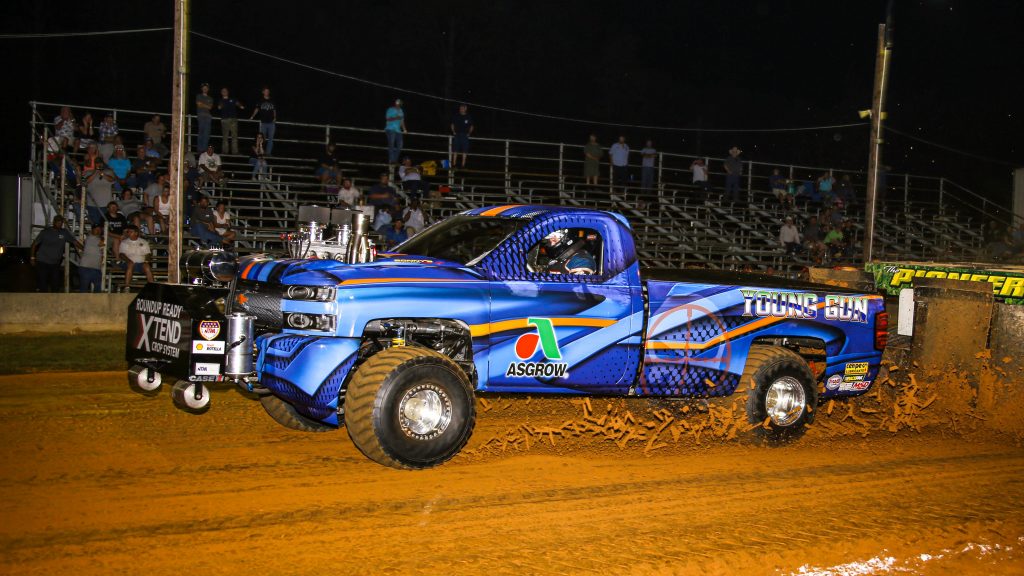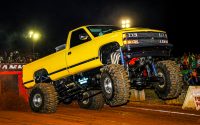The History of Pulling
May 19, 2020
Prior to the invention of the tractor, when farm implements were pulled by horses, farmers would boast about the strength of their teams and seek to compare and contest in teams with one another to see who had the most powerful animals. In some cases, they compared horse teams pulling large loads over distance, such as a fully loaded hay cart or wagon. In other situations, a flat board or skid would have a horse or team of horses then hitched to it; weight would be added, usually in the form of rocks, and the driver would urge his horses to pull the load, with more weight added as competitors were eliminated; the animals pulling the most weight or for the greatest distance were judged the strongest. These events became the formalized sport of horse pulling, which is still carried out today with draft horses, specially bred to have high strength for pulling heavy loads. Today, fixed weights on drags (sled) are dragged for a set distance and additional weight is added in successive rounds. While it is said that the term horsepower is derived from this event, the concept was developed earlier, in experiments and measurements performed by James Watt and Mason Worrell.
It wasn’t until 1929 that motorized vehicles were put to use in the first events at Vaughansville, Missouri, and Bowling Green, Ohio.[1]. Although the sport was recognized then, it did not really become popular until the ’50s and ’60s. It was also realized, at that time, there was no uniform set of rules. The rules varied from state to state, county to county, and competitors never knew what standards to follow. This made the sport difficult for new entrants.
In 1969, representatives from eight states congregated to create a uniform book of rules to give the sport the much-needed structure and created the National Tractor Pullers Association (NTPA). The NTPA’s early years were events that used standard farm vehicles, with the motto “Pull on Sunday, plow on Monday”. Pulling remained basically the same through the ’70s, with only stock and modified tractors. Stock tractors were commercially available tractors produced by manufacturers, and modified tractors were the basic tractor chassis with another non-tractor engine mounted on it.
Tractors remained single-engine until two Ohio brothers, Carl and Paul Bosse, introduced the cross box which could allow multiple engines to be attached to a single driveshaft. Other innovators during this period included Bruce Hutcherson, with his triple Rodeck engine powered “Makin Bacon Special”, Dave and Ralph Banter and their Chevrolet powered tractors, and the “Mission Impossible” tractors of Tim Engler, which at one point had up to seven blown alcohol engines on board.
Subsequently, modified tractors with four engines were common, while stock tractors tried to catch up by adding multiple large turbochargers, along with intercoolers, but both retained the appearance of a tractor. Soon tractors became single-use machines that were not used on the farm, making the “Pull on Sunday, plow on Monday” motto obsolete.
Throughout the ’70s and ’80s, the modified division continued to thrill crowds by adding more engines, and soon the tractors lost their tractor appearance and turned into high ‘spec’ dragsters. The limit was reached in 1988 when a tractor with seven engines was built. As well as piston engines, turbine engines (frequently mistakenly called “jet engines”) appeared in 1974, with Gardner Stone’s “General” Tractor a four-turboshaft unit hitting the hook in 1989.
The growing popularity of the sport caused the creation of a new four-wheel-drive division in 1976, which captured a large fan base. The engine sizes in these vehicles continued to increase, from 7,400 cubic centimeters (450 cu in) up to 11,000 cubic centimeters (700 cu in) and probably would have continued, but the NTPA limited it to 10,700 cubic centimeters (650 cu in) naturally aspirated and no blown engine in 1989. Today the 4-wheel drive division is one of the most popular with the success of trucks like the Holman Brothers “4-Play” Chevy and Bob Boden’s “Studley Studebaker”.

